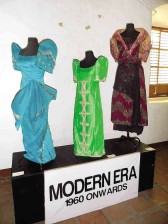‘Burdang Taal’ losing appeal

MODERN gowns are displayed during the exhibit of Taal’s embroidered crafts during the El Pasubat Festival celebration in Taal, Batangas. ROGIE REYES/CONTRIBUTOR
“Burdang Taal,” the distinct embroidery craft for which Taal town in Batangas has been known, is beginning to fray around the edges.
Far from flourishing, the home-based industry, which dates back to the Spanish colonial period when European influence on fashion reached the country, has been increasingly threatened due to modernization, declining demand for embroidered fabrics, and fewer sewers, according to the municipal tourism officer, Robert Arambulo.
Arambulo made the remarks at the close of the El Pasubat Festival held on April 26-27 as Taal celebrated its 441st founding anniversary. El Pasubat is coined from the names of Taal’s famous products, such as “empanada,” “embutido,” “longganisa,” “panutsa,” “suman,” “barong,” “balisong,” “tapa” and “tulingan.”
He said the local embroidery industry had already been surpassed “way, way a lot” by Lumban town in neighboring Laguna province. Taal could not compare with Lumban’s robust industry in terms of production and the “proactive” way by which it was being promoted by the local government, he said.
“If you go to Lumban, there is an office dedicated to embroidery services. They will show you sample designs, they control the quality, and they market the products to the designers,” Arambulo said.
Article continues after this advertisementBusiness push
Article continues after this advertisementHe said Taal’s embroidery could take off if the local government, private sector or some groups would take steps to promote, organize and make it a business so embroiderers would see it as a profitable way of life. “It’s not in their (local officials’) consciousness that they can take the product and market it.”
The local government, Arambulo said, became complacent with promoting the embroidery industry because it had been surviving on its own and patrons, like famous designer Patis Tesoro and Balikbayan Handicrafts stores in Manila, continue to order and buy burdang Taal.
He said the provincial government could also help create a venue for promoting and organizing Taal’s fineries.
Taal still has around 100 expert “burdaderas” (embroiderers), but Arambulo said some had gone abroad to seek employment.
Mary Grace Villostas, 34, an embroiderer who attended an exhibit of Taal’s traditional embroidered crafts at Escuela Pia near the Basilica of St. Martin of Tours, recalled that the municipality had planned to put up an atelier or sewing workshops (“patahian”) where embroiderers across Taal could work together.
Unfortunately, she said, it never pushed through due to lack of funding.
Villostas, who learned how to embroider when she was 12 years old, has been doing the craft consistently over the past 10 years. Like the other burdaderas, she earns only an average of P3,000 a month.
Arambulo said he was hopeful that with the increased awareness of its potentials, Taal’s embroidery industry could catch up with Lumban. What is needed is for the burdaderas to have a mind-set that this could be a career and a profitable one, too, he said.
‘Burda School’
“They (embroiderers) know that it is a trade, but they don’t see it as an active industry,” he said.
A “Burda School” may be put up for young girls to be taught by the expert burdaderas, Arambulo said. Incentives, he said, could also be given so embroidery could become a career for the young.
Another way, he said, was to have innovative designs and styles so other embroidered products catering to other home and lifestyle needs of a wider market could be tapped. “Most of the time, you’ll see the burdang Taal is still leaves and flowers … with very little innovations,” he said.
The style and designs in Lumban change according to the demand of designers or whoever places the order, “whereas here, we just do what is traditional,” Arambulo said.
Despite its limitations, burdang Taal is here to stay or is simply in its “early rebirth,” Arambulo said.